Taxation Law Assignment: Analyzing Deductions, Residency, and Income
VerifiedAdded on 2019/10/30
|10
|2142
|234
Homework Assignment
AI Summary
This taxation law assignment provides a detailed analysis of several key aspects of Australian taxation. It begins by exploring allowable deductions, specifically addressing tax agent and solicitor fees, referencing relevant sections of the ITAA 1997 and related rulings. The assignment then delves into the concept of residency, examining the tests used to determine an individual's residential status for tax purposes, particularly focusing on the case of an overseas student. The analysis continues by examining assessable income, differentiating between ordinary and statutory income, and considering the tax implications of various income sources, including employment income, tips, and gifts, while also addressing fringe benefits. Finally, the assignment concludes with a discussion of home office expenses, referencing the Taxation Ruling TR 93/30 and providing insights into the conditions under which such expenses can be claimed as deductions. The assignment provides computations and references relevant legal and taxation rulings to support the arguments.
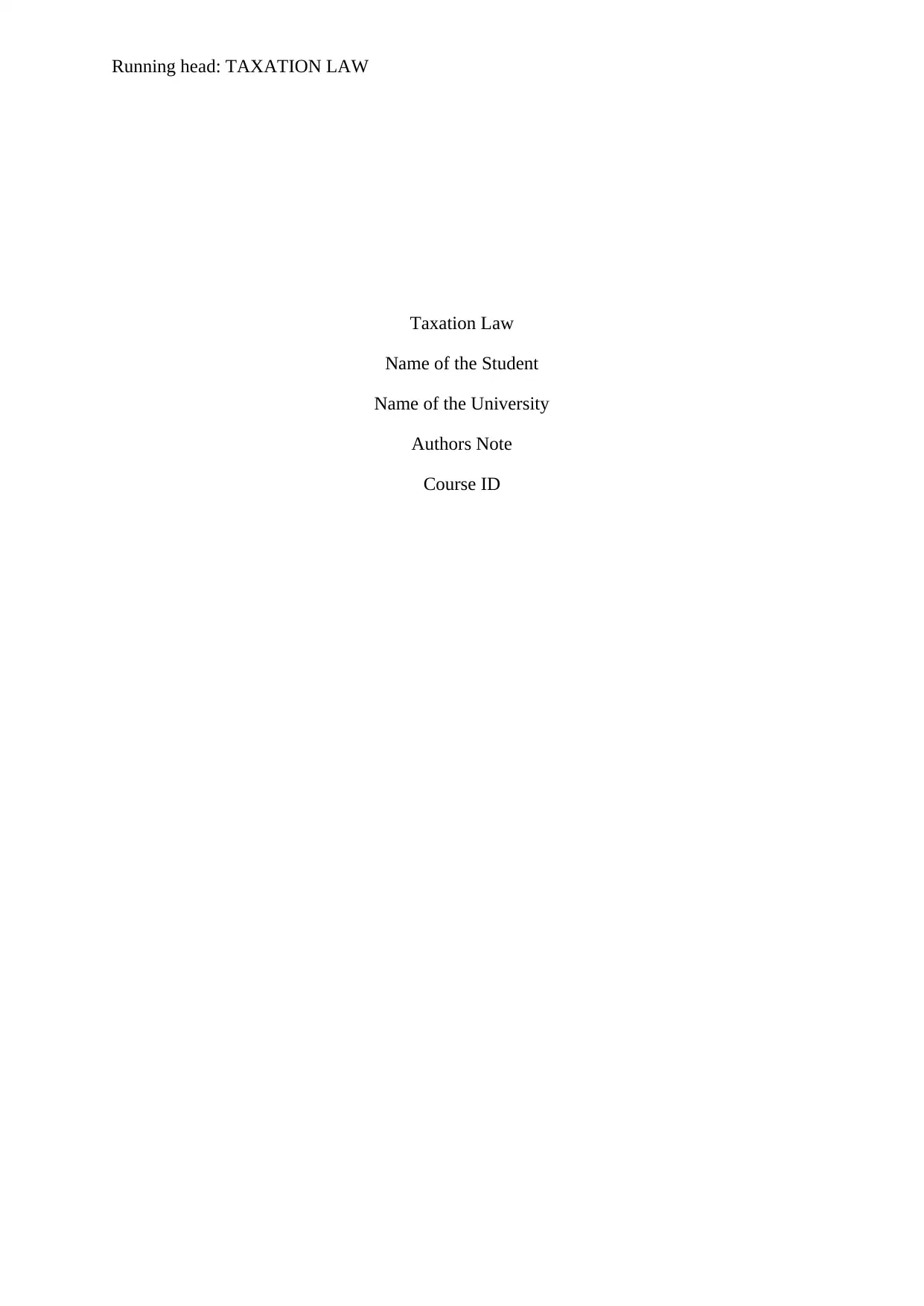
Running head: TAXATION LAW
Taxation Law
Name of the Student
Name of the University
Authors Note
Course ID
Taxation Law
Name of the Student
Name of the University
Authors Note
Course ID
Secure Best Marks with AI Grader
Need help grading? Try our AI Grader for instant feedback on your assignments.
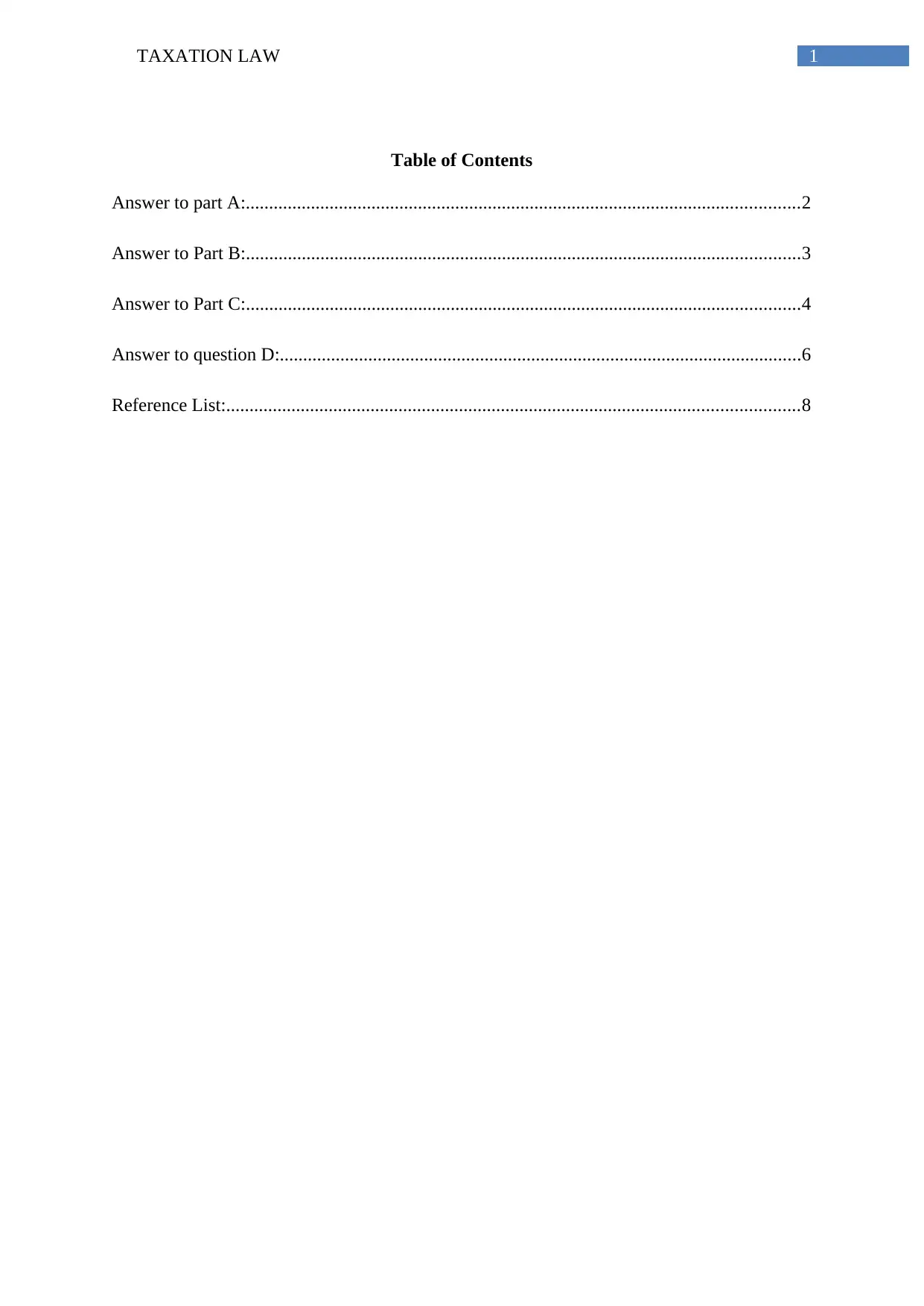
1TAXATION LAW
Table of Contents
Answer to part A:.......................................................................................................................2
Answer to Part B:.......................................................................................................................3
Answer to Part C:.......................................................................................................................4
Answer to question D:................................................................................................................6
Reference List:...........................................................................................................................8
Table of Contents
Answer to part A:.......................................................................................................................2
Answer to Part B:.......................................................................................................................3
Answer to Part C:.......................................................................................................................4
Answer to question D:................................................................................................................6
Reference List:...........................................................................................................................8
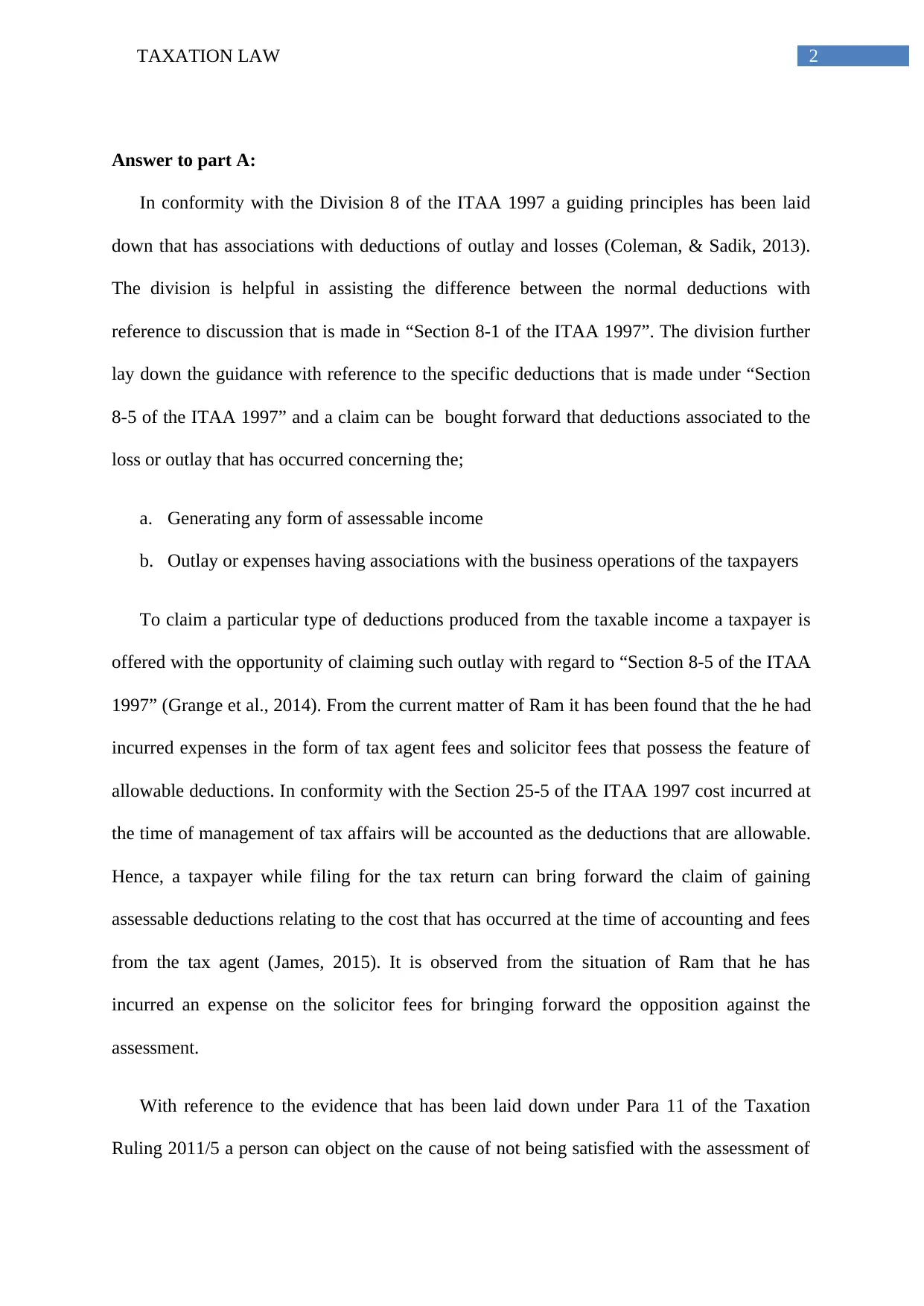
2TAXATION LAW
Answer to part A:
In conformity with the Division 8 of the ITAA 1997 a guiding principles has been laid
down that has associations with deductions of outlay and losses (Coleman, & Sadik, 2013).
The division is helpful in assisting the difference between the normal deductions with
reference to discussion that is made in “Section 8-1 of the ITAA 1997”. The division further
lay down the guidance with reference to the specific deductions that is made under “Section
8-5 of the ITAA 1997” and a claim can be bought forward that deductions associated to the
loss or outlay that has occurred concerning the;
a. Generating any form of assessable income
b. Outlay or expenses having associations with the business operations of the taxpayers
To claim a particular type of deductions produced from the taxable income a taxpayer is
offered with the opportunity of claiming such outlay with regard to “Section 8-5 of the ITAA
1997” (Grange et al., 2014). From the current matter of Ram it has been found that the he had
incurred expenses in the form of tax agent fees and solicitor fees that possess the feature of
allowable deductions. In conformity with the Section 25-5 of the ITAA 1997 cost incurred at
the time of management of tax affairs will be accounted as the deductions that are allowable.
Hence, a taxpayer while filing for the tax return can bring forward the claim of gaining
assessable deductions relating to the cost that has occurred at the time of accounting and fees
from the tax agent (James, 2015). It is observed from the situation of Ram that he has
incurred an expense on the solicitor fees for bringing forward the opposition against the
assessment.
With reference to the evidence that has been laid down under Para 11 of the Taxation
Ruling 2011/5 a person can object on the cause of not being satisfied with the assessment of
Answer to part A:
In conformity with the Division 8 of the ITAA 1997 a guiding principles has been laid
down that has associations with deductions of outlay and losses (Coleman, & Sadik, 2013).
The division is helpful in assisting the difference between the normal deductions with
reference to discussion that is made in “Section 8-1 of the ITAA 1997”. The division further
lay down the guidance with reference to the specific deductions that is made under “Section
8-5 of the ITAA 1997” and a claim can be bought forward that deductions associated to the
loss or outlay that has occurred concerning the;
a. Generating any form of assessable income
b. Outlay or expenses having associations with the business operations of the taxpayers
To claim a particular type of deductions produced from the taxable income a taxpayer is
offered with the opportunity of claiming such outlay with regard to “Section 8-5 of the ITAA
1997” (Grange et al., 2014). From the current matter of Ram it has been found that the he had
incurred expenses in the form of tax agent fees and solicitor fees that possess the feature of
allowable deductions. In conformity with the Section 25-5 of the ITAA 1997 cost incurred at
the time of management of tax affairs will be accounted as the deductions that are allowable.
Hence, a taxpayer while filing for the tax return can bring forward the claim of gaining
assessable deductions relating to the cost that has occurred at the time of accounting and fees
from the tax agent (James, 2015). It is observed from the situation of Ram that he has
incurred an expense on the solicitor fees for bringing forward the opposition against the
assessment.
With reference to the evidence that has been laid down under Para 11 of the Taxation
Ruling 2011/5 a person can object on the cause of not being satisfied with the assessment of
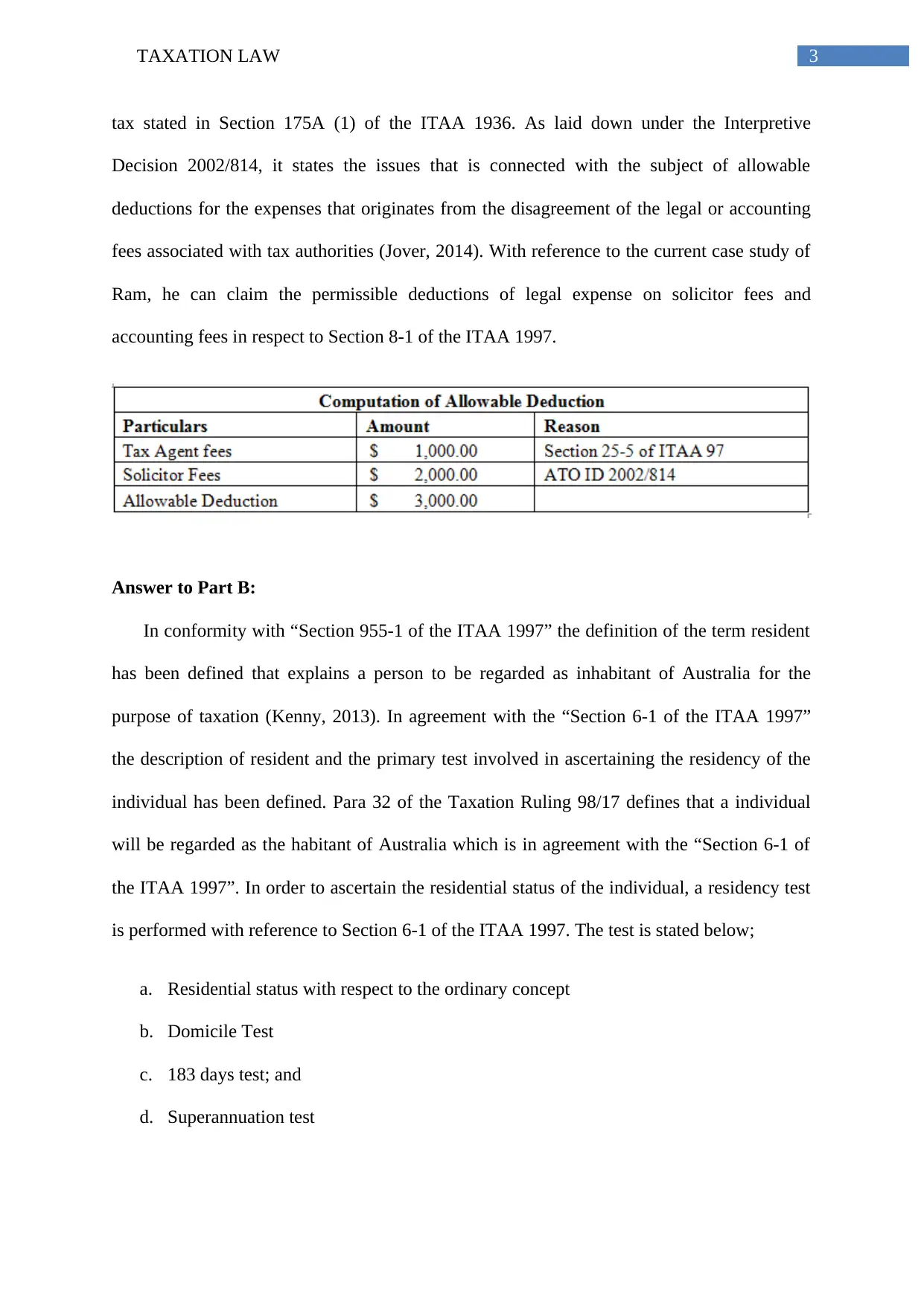
3TAXATION LAW
tax stated in Section 175A (1) of the ITAA 1936. As laid down under the Interpretive
Decision 2002/814, it states the issues that is connected with the subject of allowable
deductions for the expenses that originates from the disagreement of the legal or accounting
fees associated with tax authorities (Jover, 2014). With reference to the current case study of
Ram, he can claim the permissible deductions of legal expense on solicitor fees and
accounting fees in respect to Section 8-1 of the ITAA 1997.
Answer to Part B:
In conformity with “Section 955-1 of the ITAA 1997” the definition of the term resident
has been defined that explains a person to be regarded as inhabitant of Australia for the
purpose of taxation (Kenny, 2013). In agreement with the “Section 6-1 of the ITAA 1997”
the description of resident and the primary test involved in ascertaining the residency of the
individual has been defined. Para 32 of the Taxation Ruling 98/17 defines that a individual
will be regarded as the habitant of Australia which is in agreement with the “Section 6-1 of
the ITAA 1997”. In order to ascertain the residential status of the individual, a residency test
is performed with reference to Section 6-1 of the ITAA 1997. The test is stated below;
a. Residential status with respect to the ordinary concept
b. Domicile Test
c. 183 days test; and
d. Superannuation test
tax stated in Section 175A (1) of the ITAA 1936. As laid down under the Interpretive
Decision 2002/814, it states the issues that is connected with the subject of allowable
deductions for the expenses that originates from the disagreement of the legal or accounting
fees associated with tax authorities (Jover, 2014). With reference to the current case study of
Ram, he can claim the permissible deductions of legal expense on solicitor fees and
accounting fees in respect to Section 8-1 of the ITAA 1997.
Answer to Part B:
In conformity with “Section 955-1 of the ITAA 1997” the definition of the term resident
has been defined that explains a person to be regarded as inhabitant of Australia for the
purpose of taxation (Kenny, 2013). In agreement with the “Section 6-1 of the ITAA 1997”
the description of resident and the primary test involved in ascertaining the residency of the
individual has been defined. Para 32 of the Taxation Ruling 98/17 defines that a individual
will be regarded as the habitant of Australia which is in agreement with the “Section 6-1 of
the ITAA 1997”. In order to ascertain the residential status of the individual, a residency test
is performed with reference to Section 6-1 of the ITAA 1997. The test is stated below;
a. Residential status with respect to the ordinary concept
b. Domicile Test
c. 183 days test; and
d. Superannuation test
Secure Best Marks with AI Grader
Need help grading? Try our AI Grader for instant feedback on your assignments.
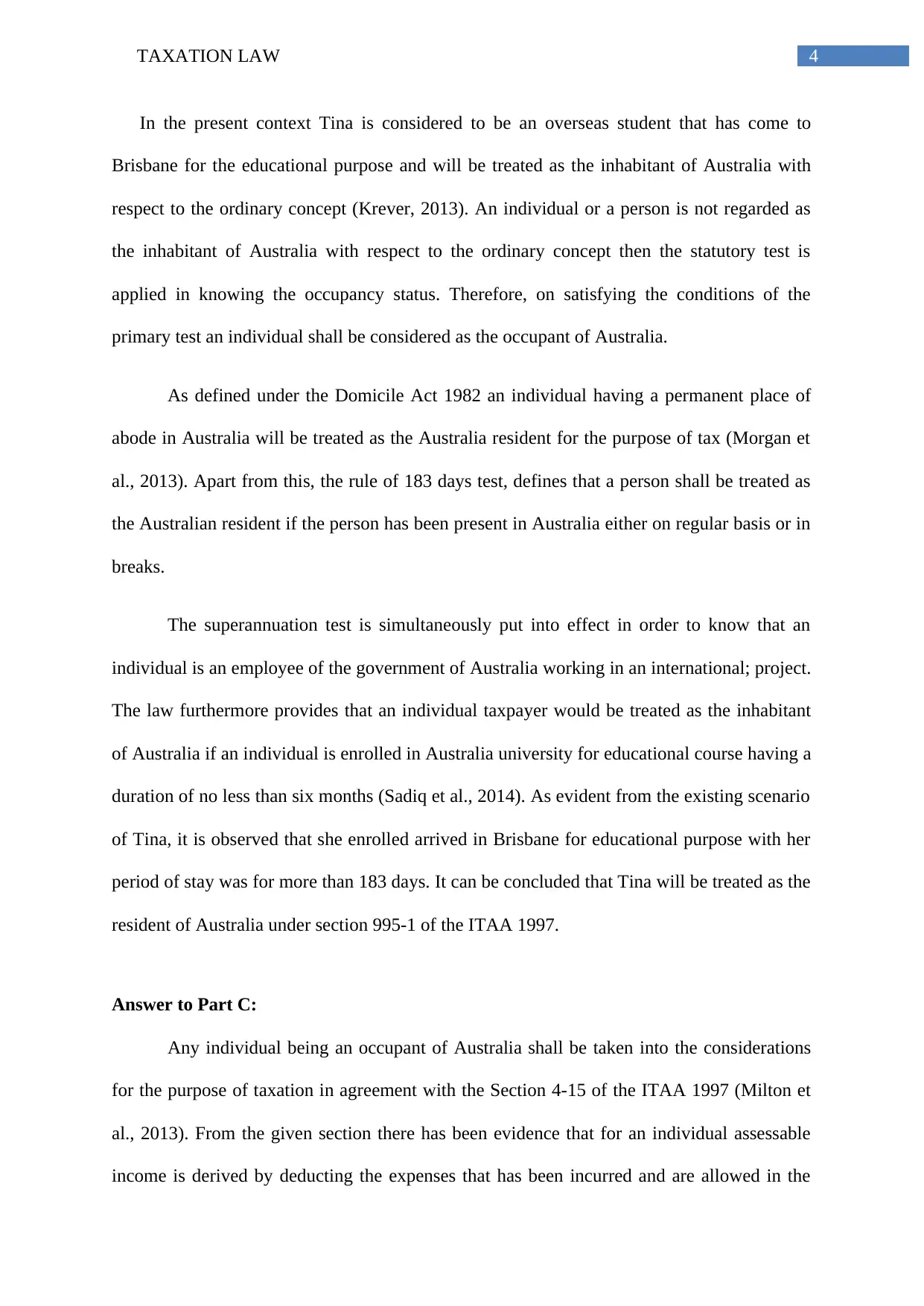
4TAXATION LAW
In the present context Tina is considered to be an overseas student that has come to
Brisbane for the educational purpose and will be treated as the inhabitant of Australia with
respect to the ordinary concept (Krever, 2013). An individual or a person is not regarded as
the inhabitant of Australia with respect to the ordinary concept then the statutory test is
applied in knowing the occupancy status. Therefore, on satisfying the conditions of the
primary test an individual shall be considered as the occupant of Australia.
As defined under the Domicile Act 1982 an individual having a permanent place of
abode in Australia will be treated as the Australia resident for the purpose of tax (Morgan et
al., 2013). Apart from this, the rule of 183 days test, defines that a person shall be treated as
the Australian resident if the person has been present in Australia either on regular basis or in
breaks.
The superannuation test is simultaneously put into effect in order to know that an
individual is an employee of the government of Australia working in an international; project.
The law furthermore provides that an individual taxpayer would be treated as the inhabitant
of Australia if an individual is enrolled in Australia university for educational course having a
duration of no less than six months (Sadiq et al., 2014). As evident from the existing scenario
of Tina, it is observed that she enrolled arrived in Brisbane for educational purpose with her
period of stay was for more than 183 days. It can be concluded that Tina will be treated as the
resident of Australia under section 995-1 of the ITAA 1997.
Answer to Part C:
Any individual being an occupant of Australia shall be taken into the considerations
for the purpose of taxation in agreement with the Section 4-15 of the ITAA 1997 (Milton et
al., 2013). From the given section there has been evidence that for an individual assessable
income is derived by deducting the expenses that has been incurred and are allowed in the
In the present context Tina is considered to be an overseas student that has come to
Brisbane for the educational purpose and will be treated as the inhabitant of Australia with
respect to the ordinary concept (Krever, 2013). An individual or a person is not regarded as
the inhabitant of Australia with respect to the ordinary concept then the statutory test is
applied in knowing the occupancy status. Therefore, on satisfying the conditions of the
primary test an individual shall be considered as the occupant of Australia.
As defined under the Domicile Act 1982 an individual having a permanent place of
abode in Australia will be treated as the Australia resident for the purpose of tax (Morgan et
al., 2013). Apart from this, the rule of 183 days test, defines that a person shall be treated as
the Australian resident if the person has been present in Australia either on regular basis or in
breaks.
The superannuation test is simultaneously put into effect in order to know that an
individual is an employee of the government of Australia working in an international; project.
The law furthermore provides that an individual taxpayer would be treated as the inhabitant
of Australia if an individual is enrolled in Australia university for educational course having a
duration of no less than six months (Sadiq et al., 2014). As evident from the existing scenario
of Tina, it is observed that she enrolled arrived in Brisbane for educational purpose with her
period of stay was for more than 183 days. It can be concluded that Tina will be treated as the
resident of Australia under section 995-1 of the ITAA 1997.
Answer to Part C:
Any individual being an occupant of Australia shall be taken into the considerations
for the purpose of taxation in agreement with the Section 4-15 of the ITAA 1997 (Milton et
al., 2013). From the given section there has been evidence that for an individual assessable
income is derived by deducting the expenses that has been incurred and are allowed in the
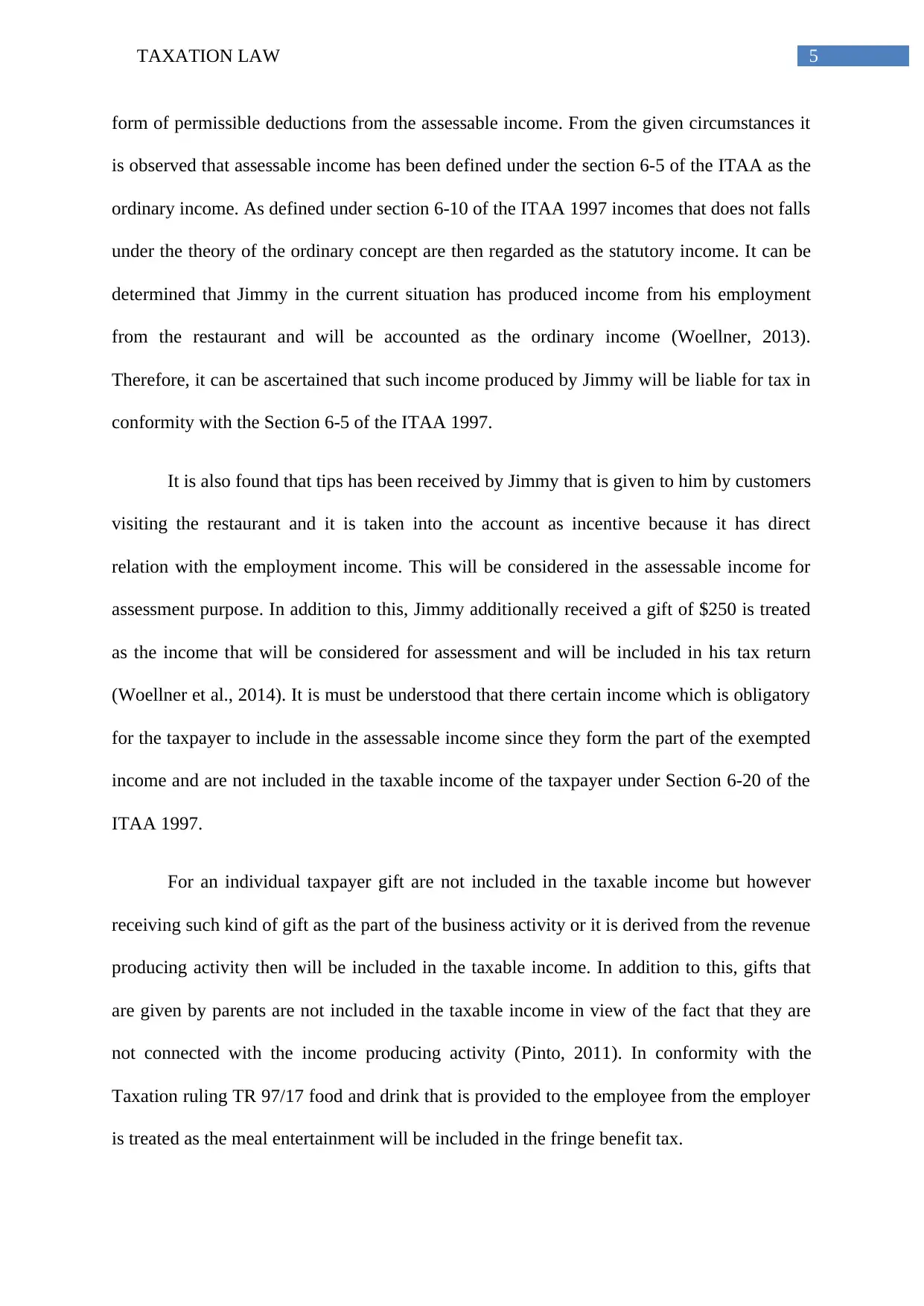
5TAXATION LAW
form of permissible deductions from the assessable income. From the given circumstances it
is observed that assessable income has been defined under the section 6-5 of the ITAA as the
ordinary income. As defined under section 6-10 of the ITAA 1997 incomes that does not falls
under the theory of the ordinary concept are then regarded as the statutory income. It can be
determined that Jimmy in the current situation has produced income from his employment
from the restaurant and will be accounted as the ordinary income (Woellner, 2013).
Therefore, it can be ascertained that such income produced by Jimmy will be liable for tax in
conformity with the Section 6-5 of the ITAA 1997.
It is also found that tips has been received by Jimmy that is given to him by customers
visiting the restaurant and it is taken into the account as incentive because it has direct
relation with the employment income. This will be considered in the assessable income for
assessment purpose. In addition to this, Jimmy additionally received a gift of $250 is treated
as the income that will be considered for assessment and will be included in his tax return
(Woellner et al., 2014). It is must be understood that there certain income which is obligatory
for the taxpayer to include in the assessable income since they form the part of the exempted
income and are not included in the taxable income of the taxpayer under Section 6-20 of the
ITAA 1997.
For an individual taxpayer gift are not included in the taxable income but however
receiving such kind of gift as the part of the business activity or it is derived from the revenue
producing activity then will be included in the taxable income. In addition to this, gifts that
are given by parents are not included in the taxable income in view of the fact that they are
not connected with the income producing activity (Pinto, 2011). In conformity with the
Taxation ruling TR 97/17 food and drink that is provided to the employee from the employer
is treated as the meal entertainment will be included in the fringe benefit tax.
form of permissible deductions from the assessable income. From the given circumstances it
is observed that assessable income has been defined under the section 6-5 of the ITAA as the
ordinary income. As defined under section 6-10 of the ITAA 1997 incomes that does not falls
under the theory of the ordinary concept are then regarded as the statutory income. It can be
determined that Jimmy in the current situation has produced income from his employment
from the restaurant and will be accounted as the ordinary income (Woellner, 2013).
Therefore, it can be ascertained that such income produced by Jimmy will be liable for tax in
conformity with the Section 6-5 of the ITAA 1997.
It is also found that tips has been received by Jimmy that is given to him by customers
visiting the restaurant and it is taken into the account as incentive because it has direct
relation with the employment income. This will be considered in the assessable income for
assessment purpose. In addition to this, Jimmy additionally received a gift of $250 is treated
as the income that will be considered for assessment and will be included in his tax return
(Woellner et al., 2014). It is must be understood that there certain income which is obligatory
for the taxpayer to include in the assessable income since they form the part of the exempted
income and are not included in the taxable income of the taxpayer under Section 6-20 of the
ITAA 1997.
For an individual taxpayer gift are not included in the taxable income but however
receiving such kind of gift as the part of the business activity or it is derived from the revenue
producing activity then will be included in the taxable income. In addition to this, gifts that
are given by parents are not included in the taxable income in view of the fact that they are
not connected with the income producing activity (Pinto, 2011). In conformity with the
Taxation ruling TR 97/17 food and drink that is provided to the employee from the employer
is treated as the meal entertainment will be included in the fringe benefit tax.
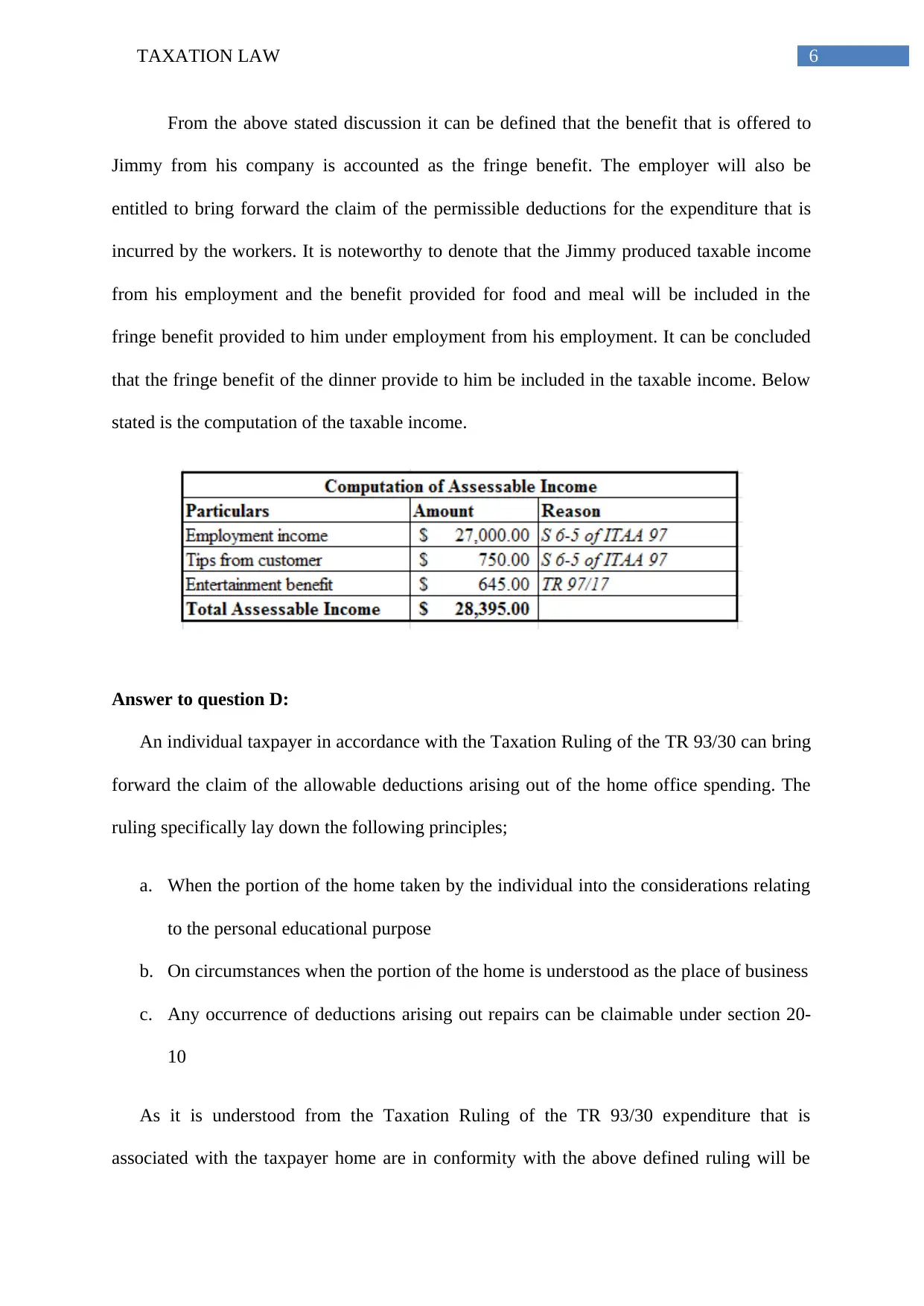
6TAXATION LAW
From the above stated discussion it can be defined that the benefit that is offered to
Jimmy from his company is accounted as the fringe benefit. The employer will also be
entitled to bring forward the claim of the permissible deductions for the expenditure that is
incurred by the workers. It is noteworthy to denote that the Jimmy produced taxable income
from his employment and the benefit provided for food and meal will be included in the
fringe benefit provided to him under employment from his employment. It can be concluded
that the fringe benefit of the dinner provide to him be included in the taxable income. Below
stated is the computation of the taxable income.
Answer to question D:
An individual taxpayer in accordance with the Taxation Ruling of the TR 93/30 can bring
forward the claim of the allowable deductions arising out of the home office spending. The
ruling specifically lay down the following principles;
a. When the portion of the home taken by the individual into the considerations relating
to the personal educational purpose
b. On circumstances when the portion of the home is understood as the place of business
c. Any occurrence of deductions arising out repairs can be claimable under section 20-
10
As it is understood from the Taxation Ruling of the TR 93/30 expenditure that is
associated with the taxpayer home are in conformity with the above defined ruling will be
From the above stated discussion it can be defined that the benefit that is offered to
Jimmy from his company is accounted as the fringe benefit. The employer will also be
entitled to bring forward the claim of the permissible deductions for the expenditure that is
incurred by the workers. It is noteworthy to denote that the Jimmy produced taxable income
from his employment and the benefit provided for food and meal will be included in the
fringe benefit provided to him under employment from his employment. It can be concluded
that the fringe benefit of the dinner provide to him be included in the taxable income. Below
stated is the computation of the taxable income.
Answer to question D:
An individual taxpayer in accordance with the Taxation Ruling of the TR 93/30 can bring
forward the claim of the allowable deductions arising out of the home office spending. The
ruling specifically lay down the following principles;
a. When the portion of the home taken by the individual into the considerations relating
to the personal educational purpose
b. On circumstances when the portion of the home is understood as the place of business
c. Any occurrence of deductions arising out repairs can be claimable under section 20-
10
As it is understood from the Taxation Ruling of the TR 93/30 expenditure that is
associated with the taxpayer home are in conformity with the above defined ruling will be
Paraphrase This Document
Need a fresh take? Get an instant paraphrase of this document with our AI Paraphraser
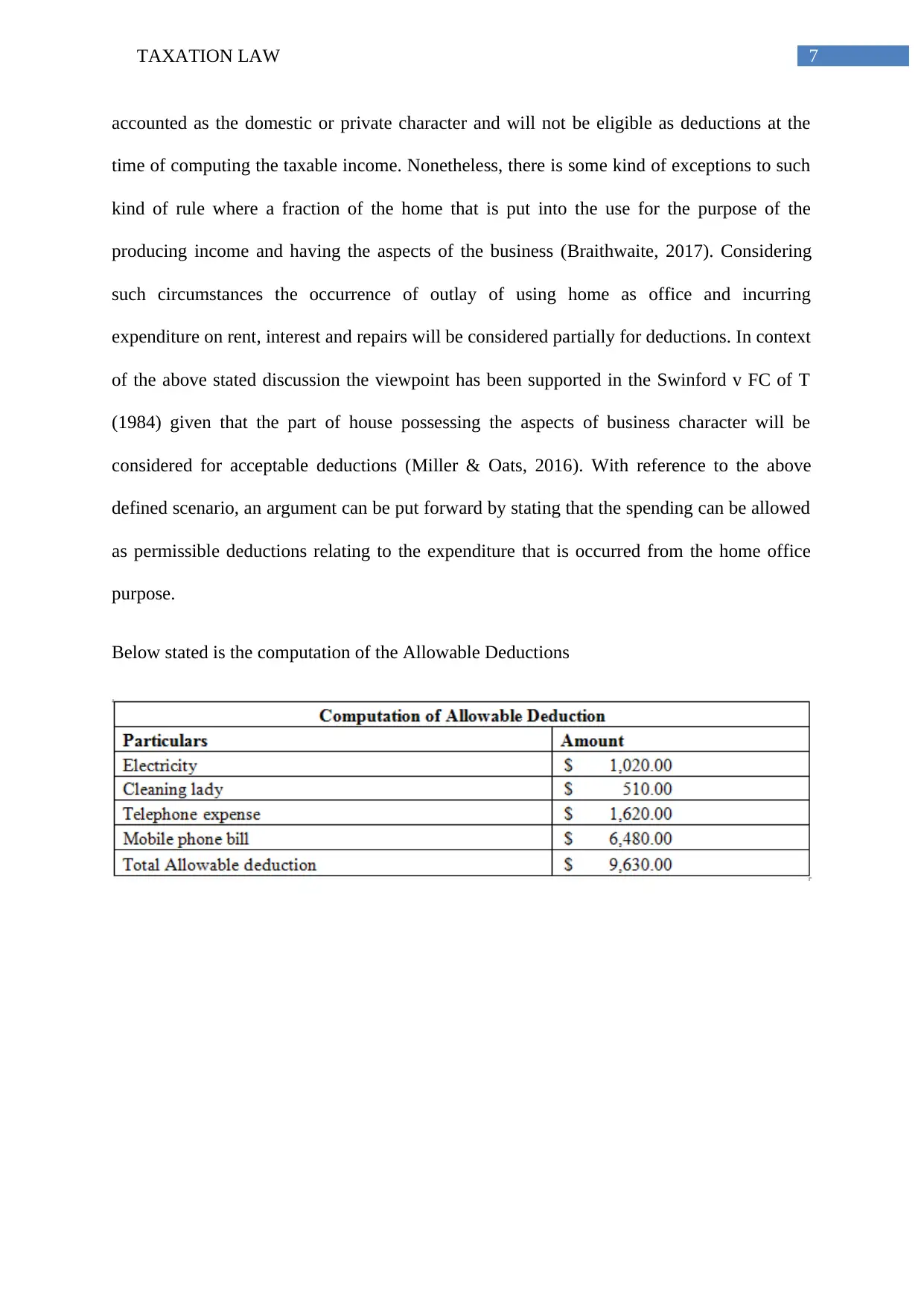
7TAXATION LAW
accounted as the domestic or private character and will not be eligible as deductions at the
time of computing the taxable income. Nonetheless, there is some kind of exceptions to such
kind of rule where a fraction of the home that is put into the use for the purpose of the
producing income and having the aspects of the business (Braithwaite, 2017). Considering
such circumstances the occurrence of outlay of using home as office and incurring
expenditure on rent, interest and repairs will be considered partially for deductions. In context
of the above stated discussion the viewpoint has been supported in the Swinford v FC of T
(1984) given that the part of house possessing the aspects of business character will be
considered for acceptable deductions (Miller & Oats, 2016). With reference to the above
defined scenario, an argument can be put forward by stating that the spending can be allowed
as permissible deductions relating to the expenditure that is occurred from the home office
purpose.
Below stated is the computation of the Allowable Deductions
accounted as the domestic or private character and will not be eligible as deductions at the
time of computing the taxable income. Nonetheless, there is some kind of exceptions to such
kind of rule where a fraction of the home that is put into the use for the purpose of the
producing income and having the aspects of the business (Braithwaite, 2017). Considering
such circumstances the occurrence of outlay of using home as office and incurring
expenditure on rent, interest and repairs will be considered partially for deductions. In context
of the above stated discussion the viewpoint has been supported in the Swinford v FC of T
(1984) given that the part of house possessing the aspects of business character will be
considered for acceptable deductions (Miller & Oats, 2016). With reference to the above
defined scenario, an argument can be put forward by stating that the spending can be allowed
as permissible deductions relating to the expenditure that is occurred from the home office
purpose.
Below stated is the computation of the Allowable Deductions

8TAXATION LAW
Reference List:
Braithwaite, V. (Ed.). (2017). Taxing democracy: Understanding tax avoidance and evasion.
Routledge.
Coleman, C., & Sadiq, K. Principles of taxation law 2013.
Grange, J., Jover-Ledesma, G., & Maydew, G. 2014 principles of business taxation.
James, M. Taxation of small businesses 2014/15.
Jover-Ledesma, G. (2014). Principles of business taxation 2015. [Place of publication not
identified]: Cch Incorporated.
Kenny, P. (2013). Australian tax 2013. Chatswood, N.S.W.: LexisNexis Butterworths.
Krever, R. (2013). Australian taxation law cases 2013. Pyrmont, N.S.W.: Thomson Reuters.
Miller, A., & Oats, L. (2016). Principles of international taxation. Bloomsbury Publishing.
Morgan, A., Mortimer, C., & Pinto, D. (2013). A practical introduction to Australian taxation
law. North Ryde [N.S.W.]: CCH Australia.
Pinto, D. (2011). State taxes. In Australian Taxation Law (pp. 1763-1762). CCH Australia
Limited.
Sadiq, K., Coleman, C., Hanegbi, R., Jogarajan, S., Krever, R., Obst, W., & Ting,
A. Principles of taxation law 2014.
The taxpayers' guide 2013 & 2014. (2013). Milton, Qld.
Woellner, R. (2013). Australian taxation law 2012. North Ryde [N.S.W.]: CCH Australia.
Woellner, R., Barkoczy, S., Murphy, S., Evans, C., & Pinto, D. Australian taxation law 2014.
Reference List:
Braithwaite, V. (Ed.). (2017). Taxing democracy: Understanding tax avoidance and evasion.
Routledge.
Coleman, C., & Sadiq, K. Principles of taxation law 2013.
Grange, J., Jover-Ledesma, G., & Maydew, G. 2014 principles of business taxation.
James, M. Taxation of small businesses 2014/15.
Jover-Ledesma, G. (2014). Principles of business taxation 2015. [Place of publication not
identified]: Cch Incorporated.
Kenny, P. (2013). Australian tax 2013. Chatswood, N.S.W.: LexisNexis Butterworths.
Krever, R. (2013). Australian taxation law cases 2013. Pyrmont, N.S.W.: Thomson Reuters.
Miller, A., & Oats, L. (2016). Principles of international taxation. Bloomsbury Publishing.
Morgan, A., Mortimer, C., & Pinto, D. (2013). A practical introduction to Australian taxation
law. North Ryde [N.S.W.]: CCH Australia.
Pinto, D. (2011). State taxes. In Australian Taxation Law (pp. 1763-1762). CCH Australia
Limited.
Sadiq, K., Coleman, C., Hanegbi, R., Jogarajan, S., Krever, R., Obst, W., & Ting,
A. Principles of taxation law 2014.
The taxpayers' guide 2013 & 2014. (2013). Milton, Qld.
Woellner, R. (2013). Australian taxation law 2012. North Ryde [N.S.W.]: CCH Australia.
Woellner, R., Barkoczy, S., Murphy, S., Evans, C., & Pinto, D. Australian taxation law 2014.
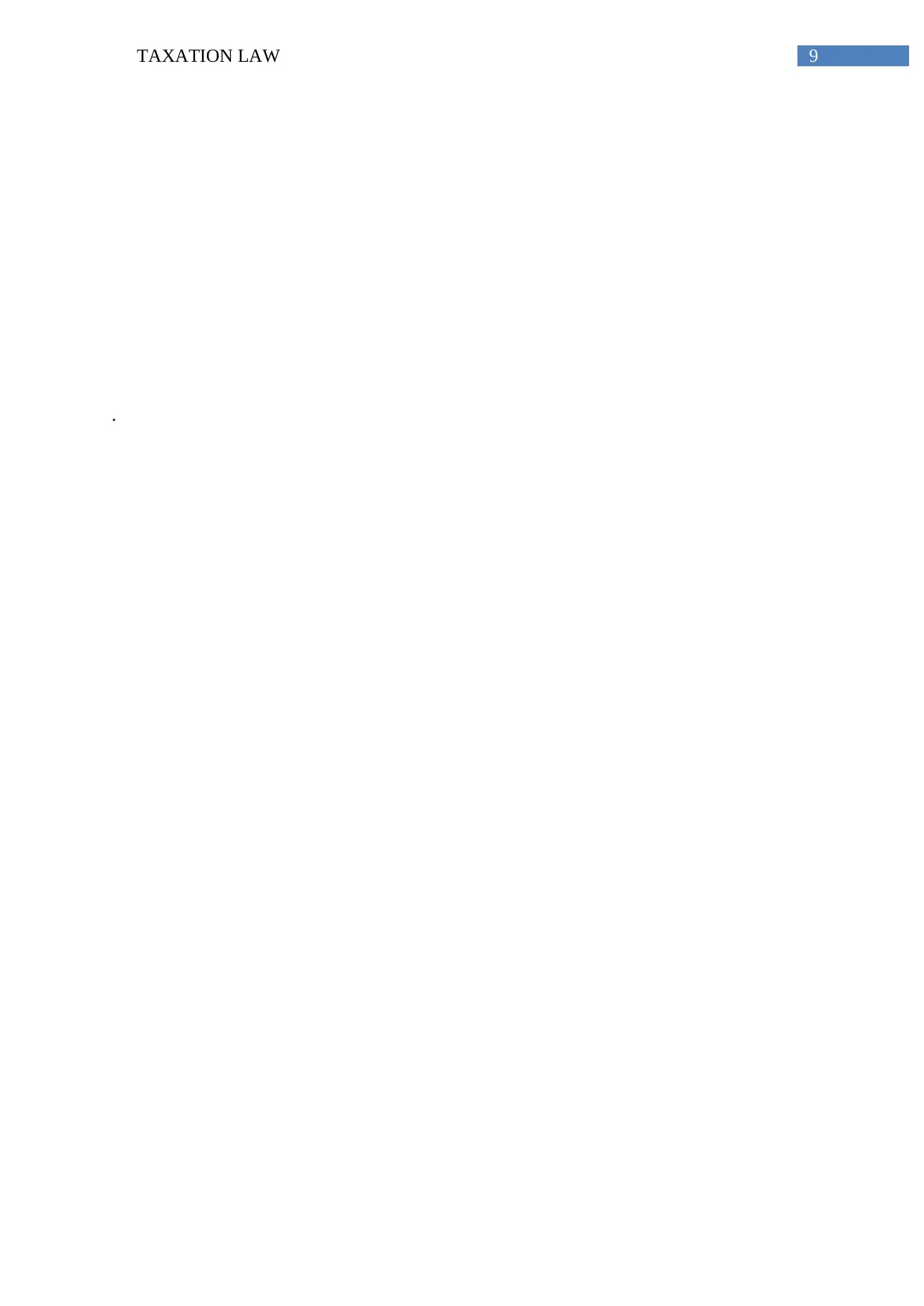
9TAXATION LAW
.
.
1 out of 10
Related Documents
Your All-in-One AI-Powered Toolkit for Academic Success.
+13062052269
info@desklib.com
Available 24*7 on WhatsApp / Email
![[object Object]](/_next/static/media/star-bottom.7253800d.svg)
Unlock your academic potential
© 2024 | Zucol Services PVT LTD | All rights reserved.





